All phonics programmes should have a ‘scope and sequence’ but what does this actually mean?
‘Scope’ means what you are teaching
When teaching reading with systematic phonics, ‘scope’ means teaching the Alphabetic Code. English has 44 sounds and more than 175 spellings for those sounds. So, do we need to teach them all? Which are essential? Educators have different ideas about how much of the Alphabetic Code you need to teach children before their reading takes off. Some children will develop word recognition sooner than others. These children will be able use their phonic knowledge and skills to decode any new word. Many of these children will have good oral language skills to help them recognise new words. Other children will take longer and will need more instruction of the Alphabetic Code. We believe that most kids benefit from teaching most of the Alphabetic Code. That doesn’t mean teaching all the 175 spellings. They need to reach a stage where they can decode new words automatically using their code knowledge and blending skills.
What is the scope in our decodable books?
Our books follow the scope and sequence of the Sounds-Write programme. In this programme the Alphabetic Code is divided into two parts:
1. The ‘Initial Code’ – the simpler part of the Alphabetic Code, which is presented to beginner readers. This includes sounds/letters of the alphabet and consonant digraphs.
2. The ‘Extended Code’ – this includes the introduction of alternative spellings for vowel and consonant sounds and some Latin suffixes.
By the time children have covered these lessons, they will have encountered most of the Alphabetic Code, but not all of it. So, for example, children will have covered alternative spellings for the sound /ae/, e.g. ai, ay, a-e, ey, a, ei etc, but they may not have been introduced to all the alternative spellings for the consonant sound /sh/ e.g. sh (ship), ch (chef), ti (nation) etc. Some advanced spellings can be introduced incidentally as new or topic words are introduced in the curriculum.
Below you can see all the spellings covered in our decodable books series.
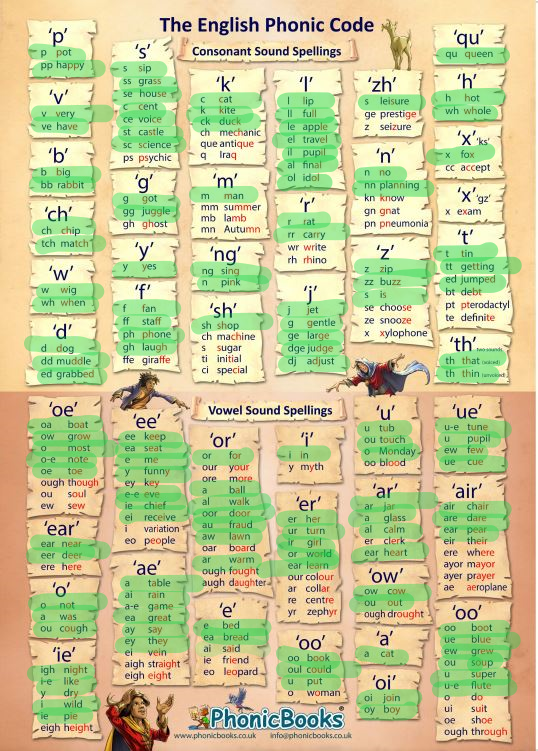
‘Sequence’ means the order of what we teach
The order of how we teach the English Alphabetic Code is very important because it is complex. It needs to ensure a structure of teaching from simple to complex that progresses in small, cumulative steps. If the order is incoherent, if it does not start at the very simple and build on previous learning or if the steps are too big, then the foundations for reading will be shaky. It is also important to include the skills that kids need (blending sounds for reading words, segmenting sounds for spelling words and phoneme manipulation for error corrections) and increase the skills level as learners progress.
Here is the sequence of our decodable books.
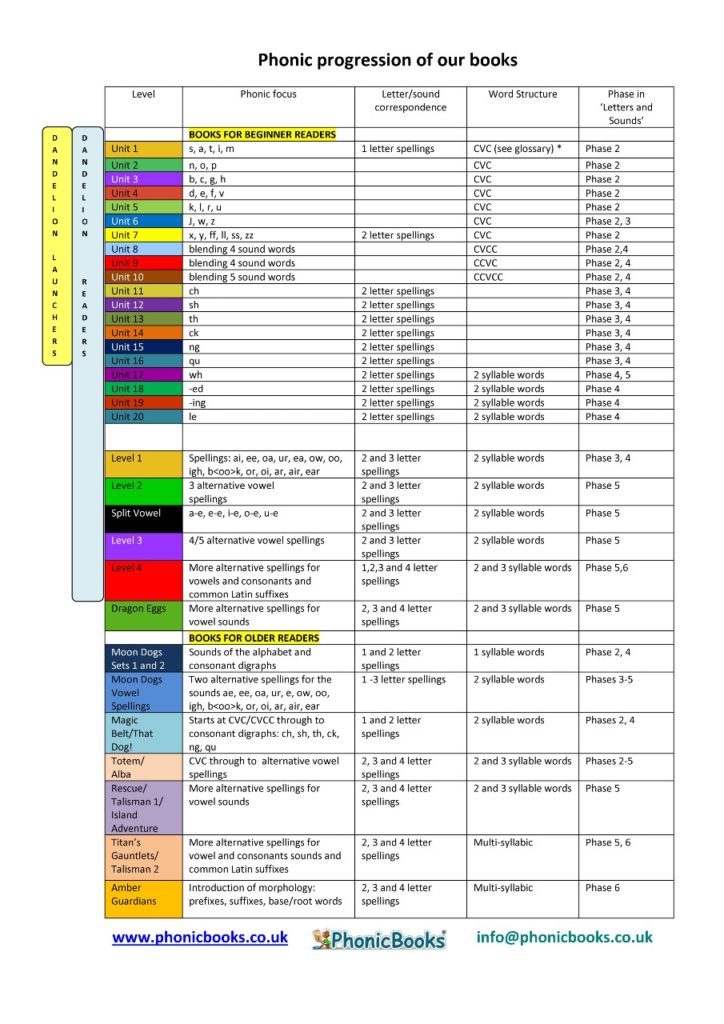
What should the order of teaching the Alphabetic Code be?
We know that sounds in English can be spelled by 1–4 letters (c a t, sh i p, n igh t, th r ough), so it is really important to start with 1:1 sound/letter correspondences, with words like ‘sit’, ‘cat’, ‘hop’ etc. Once that is in place, we can introduce the concept that two letters can spell one sound. It is logical to introduce this through double consonants, e.g. w i ll, p u ff, bu zz, as kids will have already learned these sounds/letters. Only when this has been taught, can we progress to teach that two different consonants can spell one sound, e.g. ck in ‘pick‘ or sh as in ‘ship’. As the learner progresses, we can introduce three-letter spellings (e.g. n igh t) and finally four-letter spellings (th r ough). In the chart above you can see that our Dandelion Launchers and Readers cover the Initial Code and cover words with 1:1 and 1:2 sound/letter correspondences. They also help children progress from reading three sound words (CVC words) to four and five sound words (CVCC, CCVC and CCVCC).
See here the scope and sequence of our Dandelion Launchers series. Note how only a few sounds/letters are introduced at a time (small steps), that the progression is cumulative, that double consonants are introduced in Unit (stage ) 7 and consonant digraphs in Units 11-15. Also, note that adjacent consonants are introduced in Unit 8.
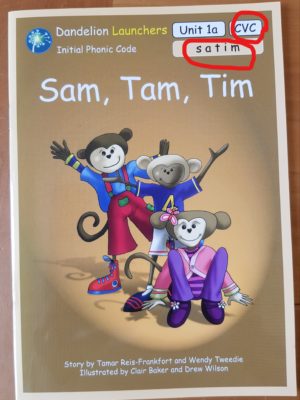
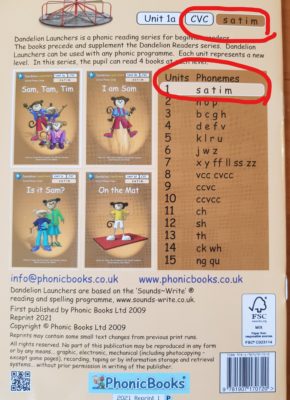
One sound – different spellings
One of the difficult concepts underpinning the Alphabetic Code is that a sound can be spelled in different ways. We introduce this concept in our Dandelion Readers series, Levels 1, 2 and 3. Some programmes will introduce just one spelling alternative and gradually introduce more. Others, like Sounds-Write, will introduce multiple spellings. The sequence of our books allows for both approaches.
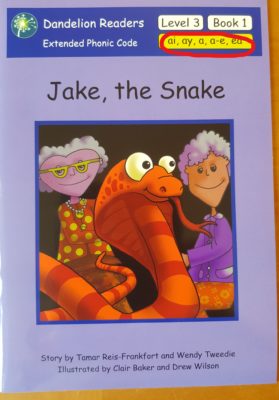
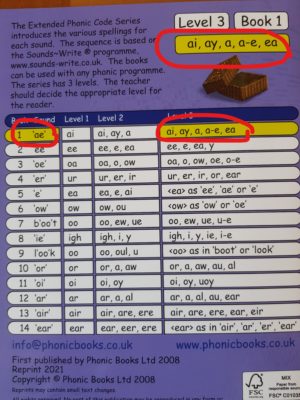
One spelling – different sounds
The other difficult concept is that a spelling, e.g. the spelling ‘ow’, can be pronounced in more than one way: /oe/ as in ‘snow’ and /ow/ as in ‘how’. We have introduced this concept in several places. Once the pupil has learnt the two alternatives for ‘ow’ for example, he/she can read decodable books with both. Note in the grid above that the right column (Level 3), book 5 (alternative sounds for the spelling ‘ea’), book 6 (alternative sounds for the spelling ‘ow’), book 9 (alternative sounds for the spelling ‘oo’) and book 14 (alternative sounds for the spelling ‘ear’) provide reading practice for this concept.
To summarise
Understanding the scope and sequence of your programme is really important. It will help you know which skills, concepts or knowledge a reader needs at each stage in order to succeed. It will help you identify where a pupil is struggling, and which kind of practice and consolidation she/he she may need, e.g. is he/she missing a bit of code knowledge to decode successfully? Is he/she lacking an understanding of a concept? Or does he/she simply need skills practice? If we can identify the difficulty, we can offer remediation and success. And reading success for all is what we are striving for!
#scopeandsequence #structuredliteracy #systematicphonics #alphabeticcode #readingintervention #phonicslearning #PhonicsTeaching #phonicsresources

